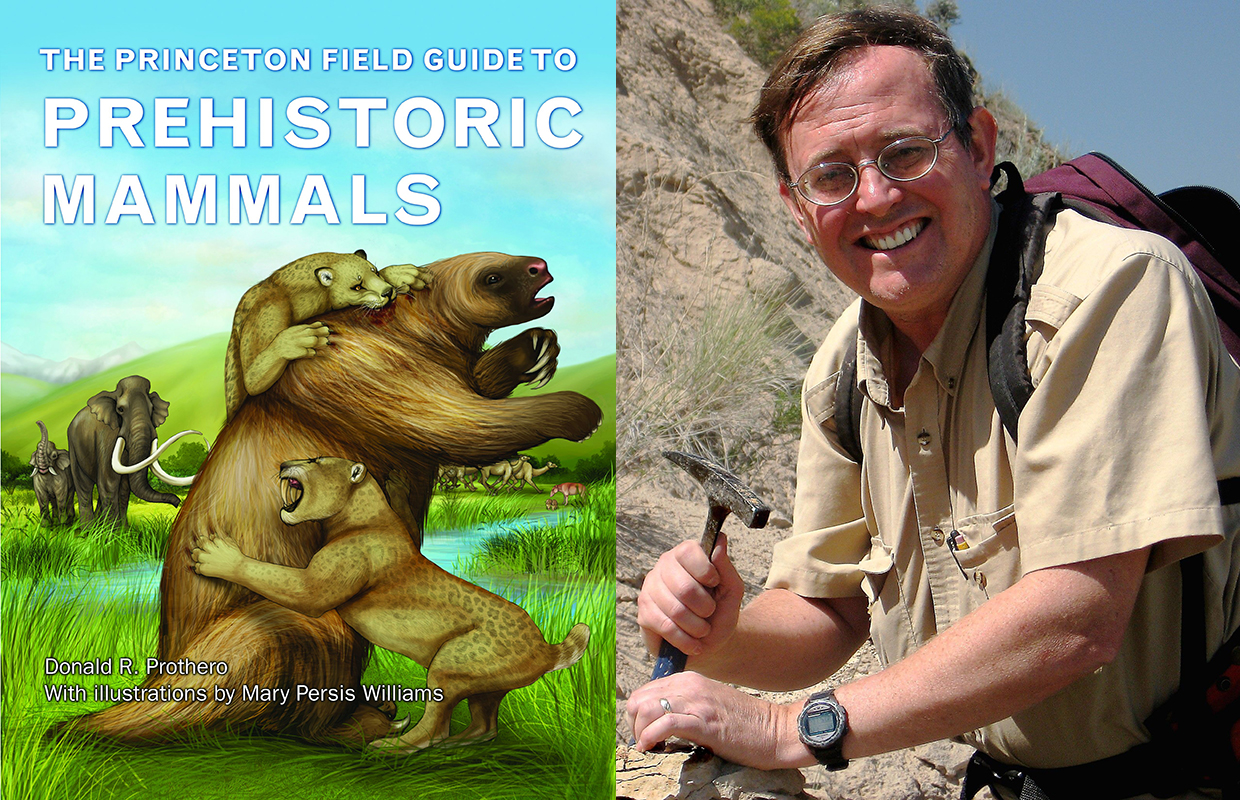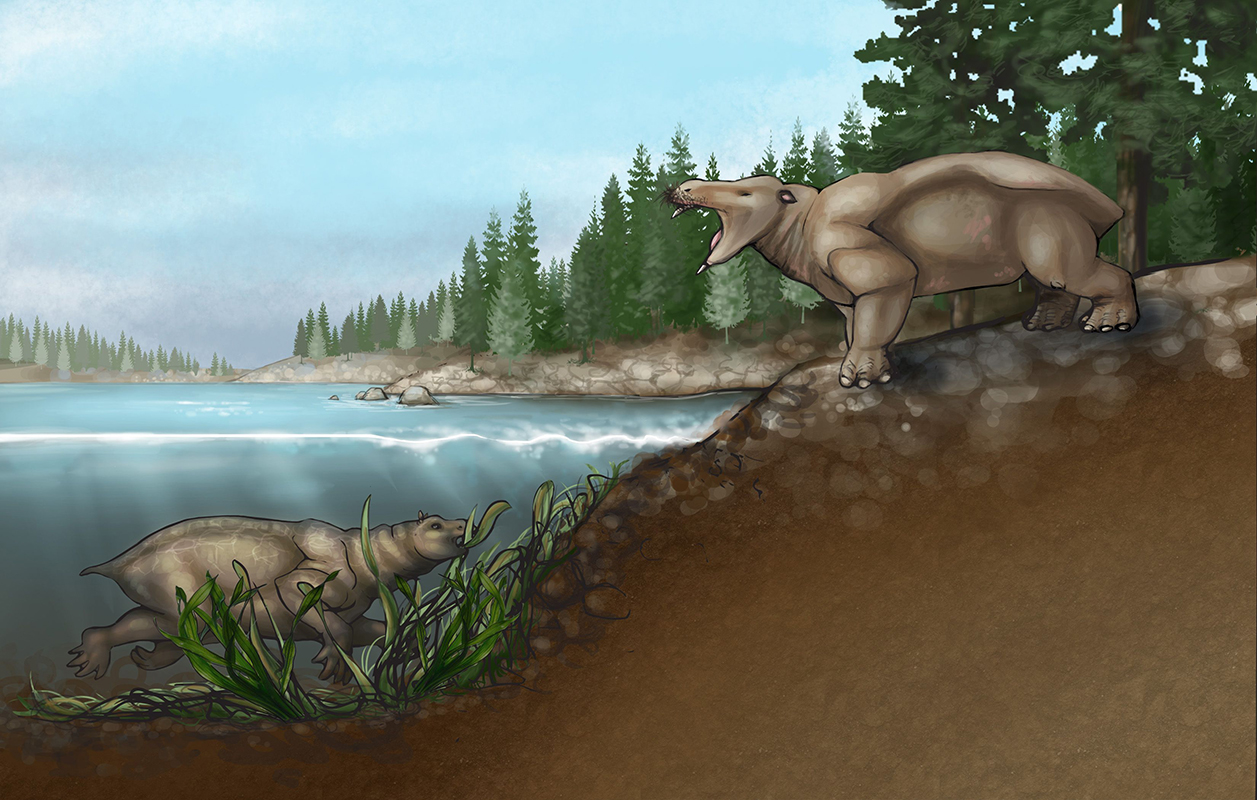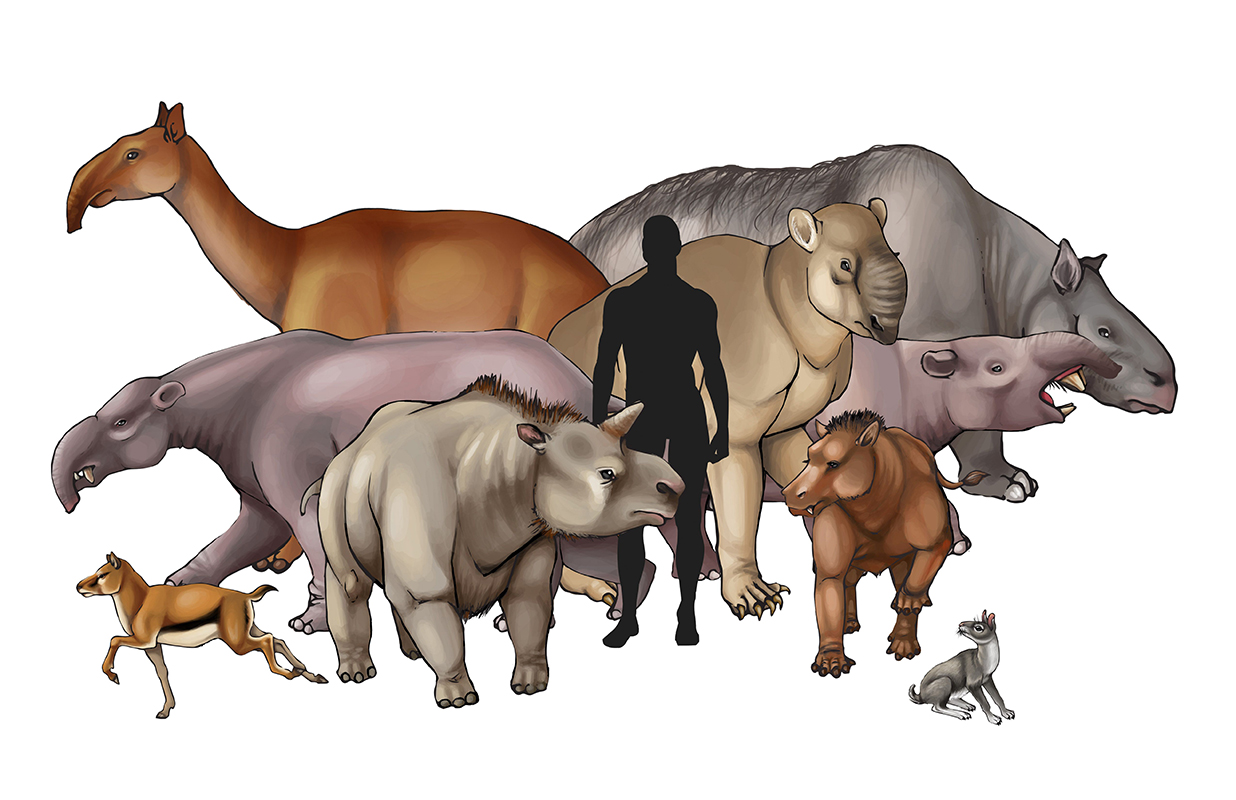Extinct Mammals Are Real-Life 'Fantastic Beasts'

If you think dinosaurs are amazing and unusual, you may want to take a closer look at your own mammalian family tree — it's brimming with extinct animals that are just as bizarre and fascinating as a duck-billed and crested hadrosaur, or a frilled and horned Triceratops.
A new, illustrated "field guide" to extinct prehistoric mammals describes the range of warm-blooded creatures of all sizes that roamed the Earth millions of years ago, and they're stranger and more spectacular than you might imagine.
In "The Princeton Field Guide to Prehistoric Mammals" (Princeton University Press, 2016), author Donald Prothero, a research associate in vertebrate paleontology at the Natural History Museum of Los Angeles County, introduces readers to an array of real-life, but seemingly fantastic, beasts — extinct mammals. [In Images: 'Field Guide' Showcases Bizarre and Magnificent Prehistoric Mammals]
Mammals first emerged during the dinosaur age, with the first so-called "true mammal" — a tiny, shrew-like creature — appearing about 160 million years ago. The group later came to dominate the planet, after the nonavian dinosaurs died out. Over time, mammals diversified into a wide range of forms, many of which can still be seen today, in their living relatives.
There were sizable carnivores: enormous and long-legged hyenas, saber-toothed cats with blade-like incisors, toothed whales larger than any swimming the oceans today, and the so-called "bear otter," which was about the size of a modern tiger.
Even more massive than the carnivores were some of the plant eaters, such as hornless rhinos with necks like a giraffe's, giant ground sloths and towering mammoths. Other extinct mammals sported peculiar ornamentation: impressive tusks that curved downward (or sharply upward), mouths that resembled shovels, or oddly shaped bony structures sprouting from the fronts of their skulls, in addition to the horns protruding from the tops of their heads.
Prothero recently spoke with Live Science to explain how this book not only spotlights some of the most charismatic mammals in the fossil record but also represents the ways that scientists group these animals together. Anatomical studies and recent innovations in molecular biology are providing a clearer picture than ever before of how these amazing animals and their modern descendants are related.
Sign up for the Live Science daily newsletter now
Get the world’s most fascinating discoveries delivered straight to your inbox.
(This Q&A has been edited for length and clarity.)
Live Science: How did you get involved with this book project?
Donald Prothero: I've worked on fossil mammals almost all my life, since I started as a paleontologist in the early 1970s. I saw that the Princeton series had a field guide to dinosaurs and was planning one for pterosaurs, but had no title for fossil mammals — which, in many ways, is actually the more interesting topic! So I decided that was something that needed to be done. I contacted the publisher at Princeton and told them I was interested, and they were interested, too.
Live Science: When it comes to paleontology, the general public usually thinks of dinosaurs as the "rock stars" of the fossil record. How could a field guide to prehistoric mammals change that?
Prothero: We do see people interested in mammals already — saber-toothed tigers and mammoths and giant rhinoceroses. I'm trying to tap into that and point out that there's a huge array of unfamiliar but equally bizarre and fascinating creatures that we have in the mammal fossil record — in many ways, even more bizarre than dinosaurs.
Live Science: How does one put together a "field guide" to extinct animals?
Prothero: You obviously can't have a true field guide for creatures that are extinct. "The Princeton Field Guide to Dinosaurs" is more of a catalog of all the extinct dinosaurs — but there are only a couple hundred species of dinosaurs that are known, and there are more than 20,000 species of extinct and living mammals! I realized I couldn't do what Greg Paul [author of "The Field Guide to Dinosaurs"] did, because there are way too many fossil mammals. So I had to be very selective in how I went about approaching this; I really focused on the interesting and the unusual ones in each family. [12 Amazing Saber-Toothed Animals]
Live Science: What was the biggest challenge of making those selections?
Prothero: It was trying to decide how much weight to give this and how much weight to give that. For example, in terms of diversity, rodents are by far the most abundant vertebrates on Earth; they were more abundant than dinosaurs by an order of magnitude. But I don't think I could get an audience too excited about 700 species of rodents. So I chose to give the rodents just a highlight or two, and indicated how I could not do them justice.
When you look at a modern mammal field guide, it would be dominated by rodents and bats. Those are the things that are most common today, and you'd only see three pages on large mammals. But in the fossil record, it's actually the opposite — large mammals are well preserved, and they're also much more interesting to most lay readers, so that's what I focused on. And there are a lot of them, and there are a lot of things people don't know about them. [In Photos: Mammals Through Time]

Live Science: Describe the world of prehistoric mammals. What kind of ecosystems did they inhabit, and how were their environments different from the world as we know it today?
Prothero: Two-thirds of fossil mammal history was in the age of dinosaurs. Back in the late Triassic, it was just little rat-sized creatures hiding in the dark and the vegetation. It was a greenhouse planet with no ice anywhere at all, very high sea levels and very warm climates — all of which favored dinosaurs, and mammals had to live with the fact that they were in a world with a great reptilian overlord.
But when the nonbird dinosaurs vanished 66 million years ago, the world opened up to mammals. It was still a greenhouse planet in the early age of mammals — there were still tropical rainforests all the way to Montana and North Dakota. Even above the Arctic Circle, there were alligators and crocodiles, and there were lots of mammals as well.
But then that planet changed in the course of its climate over the last 50 million years, and the greenhouse world of the dinosaurs gradually vanished, got drier and colder in various phases through the latter part of the age of mammals, until the last 2 million years, where we've been in ice ages ever since.
Live Science: The book is full of illustrations representing so many kinds of extinct mammals. How do paleoartists reconstruct what these animals may have looked like in life?
Prothero: From the bones, you can be pretty confident of the shape of the body, and the amount of muscles they had in various places — that's fairly well established by just doing basic animal anatomy. And most groups have living descendants, so you can base it on that as well, and also what kind of fur they might have had. Coloration is simply a matter of taste. So, it's a mixture of things that we're confident about, based on evidence, and things which are really artistic license. [Image Gallery: Evolution's Most Extreme Mammals]

Live Science: Have recent discoveries changed how paleontologists view the mammal family tree?
Prothero: There was what was called the cladistics, or the classification revolution, in paleomammalogy, in the 1970s and 1980s. By the 1990s, we had sorted out a lot of the relationships between living and extinct mammals at a level that had never been possible before cladistics came along.
Over the same period of time, molecular biology made huge breakthroughs. By the end of the 1990s into the early 2000s, we had very powerful molecular evidence for how mammals were related — and most of that confirmed what we already decided was true based on anatomy.
Now there are mammal groups that are based on molecular evidence only, because we don't have any anatomy to support them yet. I felt it was time to go ahead and put that in the book, to show that this is where the state of research is as of today, that we really have a very different perspective on how all of these things are related.
For example, there's good evidence that ties elephants together with things like manatees — a lot of anatomical and fossil evidence first, and when they started doing molecular biology, it was even more strongly supported.
But then, molecular studies add things like tenrecs, which are these insectivorous mammals from Madagascar, and golden moles, and aardvarks, that you would never cluster with things like elephants, because they don't have any anatomical reasons that connect them.
So that group has been called on evidence from molecules only, the "Afrotheria," because they all seem to have origins in Africa. But we've yet to find any anatomical character that ties an aardvark and a tenrec and a golden mole and all these other things to elephants and manatees. [Wipe Out: History's Most Mysterious Extinctions]
Live Science: What do you hope that readers will get out of this field guide?
Prothero: It's a fun book to flip through, is the first thing. It's full of amazing and bizarre creatures, many of which have never been illustrated — or adequately illustrated — in any book for a lay audience.
And there are a lot of new discoveries here. We found many, many more weird mammals than they've ever heard of before. There are other books published on fossil mammals, but now they're grossly out of date, both because they use old-fashioned classification schemes that are now obsolete and because they don't catch up with what we now know, all the newer discoveries about these mammals. Even people who think they know something about fossil mammals will find there are surprises.
"The Princeton Field Guide to Prehistoric Mammals" was published Nov. 15.
Original article on Live Science.

Mindy Weisberger is an editor at Scholastic and a former Live Science channel editor and senior writer. She has reported on general science, covering climate change, paleontology, biology and space. Mindy studied film at Columbia University; prior to Live Science she produced, wrote and directed media for the American Museum of Natural History in New York City. Her videos about dinosaurs, astrophysics, biodiversity and evolution appear in museums and science centers worldwide, earning awards such as the CINE Golden Eagle and the Communicator Award of Excellence. Her writing has also appeared in Scientific American, The Washington Post and How It Works Magazine. Her book "Rise of the Zombie Bugs: The Surprising Science of Parasitic Mind Control" will be published in spring 2025 by Johns Hopkins University Press.










